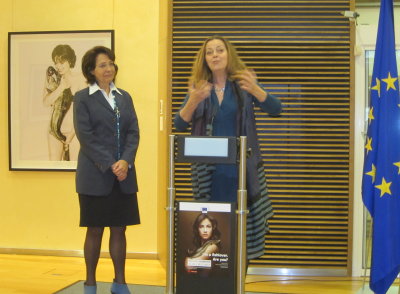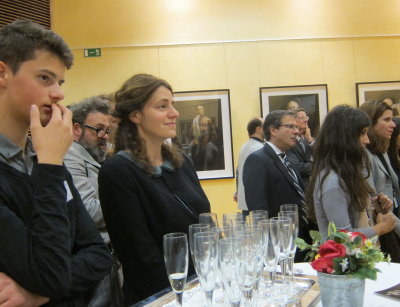Vernissage upon the invitation of EU Commissioner for Maritime Affairs, Maria Damanaki
Brussels, Berlaymont Building, 21 October 2013.
Fishlove is the brain child of Nicholas Röhl, owner of a sushi restaurant in the UK and concerned about the future of his business. Back in 2009 he was getting worried about the extent of overfishing and was looking for ways to contribute to stopping it. As babyfish are not naturally as cute as baby mammals, he wondered how to get people more emotionally engaged. This is when he borrowed from the campaign against fur coats. The idea? Create an intimacy between human skin and fish and other marine creatures. Contacting famous photographers and screen artists, he wanted to shock – cold, glibbery, slimy fish skin on naked humans. And shock they did. The first photo hit the media headlines and since, more photographers and some 50 actors, theatre directors and other artists – and of course, many species of fish, shell fish and cephalopods – have engaged with the project to show how humans care for marine life.
EU Commissioner Maria Damanaki opened the vernissage of the Fishlove photo exhibition in the first floor of the Berlaymont Building expressing her appreciation for the unusual effort at supporting the on-going reform process of the Common Fisheries Policy.
She understands very well that in addition to the facts which are clear and in everybody’s sight, the emotions and people’s deeper values need to be touched for things to change for the better. Protecting the fish more effectively means also enabling a future for the fisheries, which would otherwise draw to a close as we know it in just over a generation.
Already nominal catches from the North Sea have crashed from a peak of 3.5 million tonnes in 1995 to less than 1.5 million tonnes in 2007. There are indications of timid recovery of late, but it’s far too early to relax. As several speakers were underscoring, the eyes are on the European Parliament to prevent wasteful subsidies being voted through that would undo any protection gains.



Greta Scacchi vividly explained how she had gotten involved with the fishlove concept and how she was militating among her friends to do likewise. She said she found it unbearable to accept that in as little as one generation so many species of fish and other sea creatures had turned from very abundant to threatened status. She echoed Nicholas Röhl’s concern that the next generation might not see, let along enjoy eating them. She invited the guests of the vernissage to be supportive of the project and protect the fish for a healthier future.
Finally, Emmanuel de Brantes, gallerist specialised in urban art and erudite commentator of French cultural life, reiterated the importance of the project and the need to reconnect to fish, to the sea and to the entire earth.
Throughout the audience followed the talks attentively.
On display were pictures, among others, of Kenzo, Lizzy Jagger, Michael Gambon, Mélanie Laurant, Caroline Ducey and others. The reflexes on the glass frames somewhat detracted from the esthetic appreciation of Rankin’s and Alan Gelati’s portrait photographs.
The poses of some of the naked women may raise eyebrows of feminists, but the art photography contrasting human and fish skin in often caring embrace surely even goes beyond the intended shock. The artfully constructed photos make the creatures lovable and make one think about the connectedness in nature. Will you also care?
Let concrete protection measures follow the stark emotions evoked by the images so that the original purpose is achieved. It’s great to see so many public figures engage for the future of fish.
